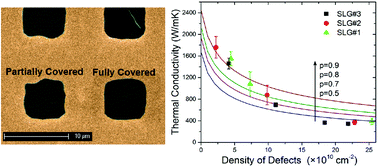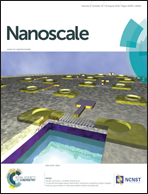Thermal conductivity of graphene with defects induced by electron beam irradiation†
Abstract
We investigate the thermal conductivity of suspended graphene as a function of the density of defects, ND, introduced in a controllable way. High-quality graphene layers are synthesized using chemical vapor deposition, transferred onto a transmission electron microscopy grid, and suspended over ∼7.5 μm size square holes. Defects are induced by irradiation of graphene with the low-energy electron beam (20 keV) and quantified by the Raman D-to-G peak intensity ratio. As the defect density changes from 2.0 × 1010 cm−2 to 1.8 × 1011 cm−2 the thermal conductivity decreases from ∼(1.8 ± 0.2) × 103 W mK−1 to ∼(4.0 ± 0.2) × 102 W mK−1 near room temperature. At higher defect densities, the thermal conductivity reveals an intriguing saturation-type behavior at a relatively high value of ∼400 W mK−1. The thermal conductivity dependence on the defect density is analyzed using the Boltzmann transport equation and molecular dynamics simulations. The results are important for understanding phonon – point defect scattering in two-dimensional systems and for practical applications of graphene in thermal management.


 Please wait while we load your content...
Please wait while we load your content...